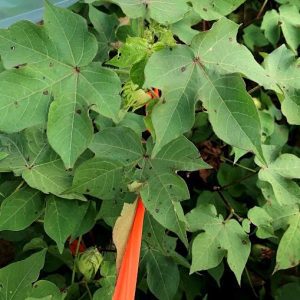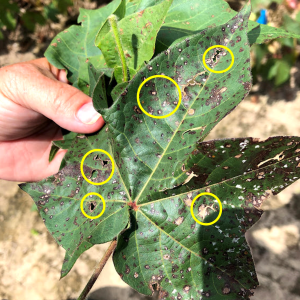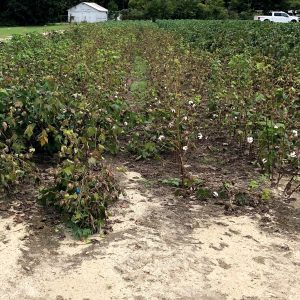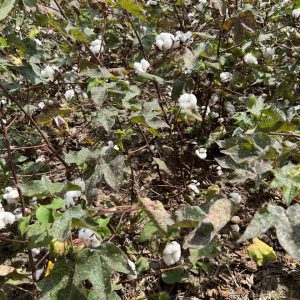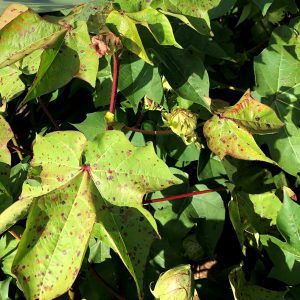Crop Production

Stemphylium leaf spot is a secondary fungal disease commonly associated with potash (K) deficiency in cotton. Prevention of potassium deficiency and other sources of plant stress is essential to reduce the risk of disease development.
Stemphylium leaf spot, caused by Stemphylium solani, is typically first observed mid-to-late season as bolls begin to fill and more potassium is required to maintain water pressure for fiber elongation. If sufficient potassium is unavailable, removing potassium from the leaves can increase susceptibility to disease.
Yield losses can be high in Stemphylium-infected cotton; however, plant stress factors such as nutrient deficiencies, drought, and pest pressure also contribute to yield losses.
Distribution
Stemphylium leaf spot can occur in potassium-deficient cotton in both dry-land and irrigated fields throughout Alabama. It is often found in dry-land fields during periods of drought stress or where roots are restricted due to a hard pan. Dry weather reduces the ability of the root system to obtain potassium from the soil. This leads to the depletion of reserves in plant tissues as the boll demand for potassium increases.
Irrigated cotton with high yield potential also can be affected. In deep sandy soils, heavy irrigation or prolonged periods of heavy rain can cause potassium to leach from the soil, resulting in reduced potassium levels. In most cases, the more common issue is the presence of underdeveloped roots as a result of heavy irrigation or rain events.
Signs and Symptoms
Stemphylium leaf spot first appears as small, circular, brown-colored lesions approximately 2 centimeters in size in the upper canopy (figure 1). Lesions start at the leaf margin and move inward. As lesions mature, the centers turn white and may crack and fall out, producing a “shot-hole” appearance (figure 2). Lesions continue to expand and grow together (coalesce), causing them to have an irregular shape. As the disease progresses, premature defoliation can occur (figure 3).
Stemphylium leaf spot often forms a complex with other foliar diseases, such as target spot and areolate mildew, to defoliate cotton in central and south Alabama (figure 4). Affected plants also demonstrate symptoms of other nutrient deficiencies and may appear yellow and red in color (figure 5).
- Figure 1. Stemphylium leaf spot first appears as small, circular brown colored lesions ~ 2 cm in size in the upper canopy.
- Figure 2. The center of Stemphylium leaf spot lesions will turn white and may crack and fall out producing a “shot-hole.” appearance.
- Figure 3. Cotton plants exhibiting symptoms of premature defoliation due to Stemphylium leaf spot and potash deficiencies. appearance.
- Figure 4. Premature defoliation caused by Stemphylium leaf spot and areolate mildew.
- Figure 5. Cotton plants exhibiting symptoms of Stemphylium leaf spot and nutrient deficiencies.
Disease Cycle
S. solani overwinters on plant residue in the soil between crop seasons. Fungal spores spread to healthy cotton tissue via wind or rain/irrigation. It is considered a weak parasite, most often infecting cotton under stress due to potassium or other nutrient deficiencies, drought, soil compaction, or pest pressure.
Stemphylium leaf spot typically first appears around the fourth week of bloom in cotton plants with a heavy fruit/boll load; this corresponds to the increased demand for potassium. Plant root growth begins to decline due to competition for carbohydrates by developing bolls; this further reduces root capacity to uptake potassium from the soil. Plants begin to rapidly remove potassium from the leaves, which reduces cell strength and increases susceptibility to diseases.
Management Practices
Since Stemphylium leaf spot is a secondary problem brought on by plant stress, fungicides do not reduce disease severity or provide yield protection. Management practices should focus on preventing potassium deficiency and other sources of plant stress to reduce the risk of disease development. Losses can be reduced by adopting the following integrated pest management (IPM) strategies:
Ensure fields have proper levels of potassium and other nutrients. Consider testing fertility levels in fields before planting to ensure adequate levels of potassium and other nutrients, such as magnesium and calcium. In sandy soils with a history of Stemphylium, it may help to apply half the recommended amount of potassium at planting and the other half around the first square. It is also vital to avoid overfertilizing with potassium as this can affect the balance of other nutrients.
When possible, monitor fields throughout the growing season for potassium deficiencies and Stemphylium leaf spot, especially as the crop moves toward peak bloom. If potassium deficiencies are caught before the fourth week of bloom, a foliar application of potash may lessen damage in irrigated fields or dry-land fields with adequate moisture. Since foliar applications deliver only a few pounds of potassium, they are not a means of correcting a significant deficit. However, they may sustain leaf health for a few days to a couple of weeks. Tissue testing can help detect potassium deficiencies up to 2 weeks before symptom development and can be used to determine if foliar potash application is required.
If potassium deficiency is not detected until late in the growing season (sixth week of bloom) or until leaf spot/defoliation becomes noticeable, foliar potash sprays will not correct the issue and will not prevent yield reductions. This is partly due to the limited amount of potassium delivered and the advanced decline of leaf health and integrity.
Applying foliar sprays of potash in fields under drought stress is not recommended. The plant may be unable to take it up, and there is an increased risk of foliar burn.
Even with a good fertility program, potassium deficiencies and, subsequently Stemphylium leaf spot, may occur. This is because early-season plant stresses prevent sufficient potassium uptake during the pre-boll period.
Avoid drought stress and manage irrigation. Stemphylium leaf spot is often found in cotton fields under drought stress. Drought reduces the ability of the root system to obtain potassium and other nutrients from the soil. Stemphylium also can be a problem in heavily irrigated fields or during prolonged periods of heavy rain, which causes potassium to leach from the soil. It is best to manage irrigation to avoid both drought stress and overwatering.
Eliminate hard pans. Cotton plant roots can be examined for j-rooting to check for hard pans. A penetrometer or rod also can be used to check for hard pans. Hard pans can be eliminated by in-row subsoiling.
Minimize damage from other pests. Anything that damages the root system, such as nematodes or soilborne diseases, can impede the uptake of nutrients from the soil. Stemphylium leaf spot can form a complex with other foliar diseases, such as areolate mildew, bacterial blight, and target spot, that defoliate cotton.
Always follow best management practices to minimize damage from other pests and reduce plant stress. For more information on management recommendations to control cotton pests in Alabama, see Cotton IPM Guide (Extension publication IPM-0415).
 Amanda Strayer-Scherer, Extension Plant Pathologist, Assistant Professor, Entomology and Plant Pathology; Eddie McGriff, Extension Agronomic Crops Regional Agent; Steve Brown, Extension Cotton Agronomist, Assistant Professor, Crop, Soil, and Environmental Sciences; and Audrey Gamble, Assistant Professor, Crop, Soil, and Environmental Sciences, all with Auburn University
Amanda Strayer-Scherer, Extension Plant Pathologist, Assistant Professor, Entomology and Plant Pathology; Eddie McGriff, Extension Agronomic Crops Regional Agent; Steve Brown, Extension Cotton Agronomist, Assistant Professor, Crop, Soil, and Environmental Sciences; and Audrey Gamble, Assistant Professor, Crop, Soil, and Environmental Sciences, all with Auburn University
New January 2023, Stemphylium Leaf Spot of Cotton, ANR-2944


